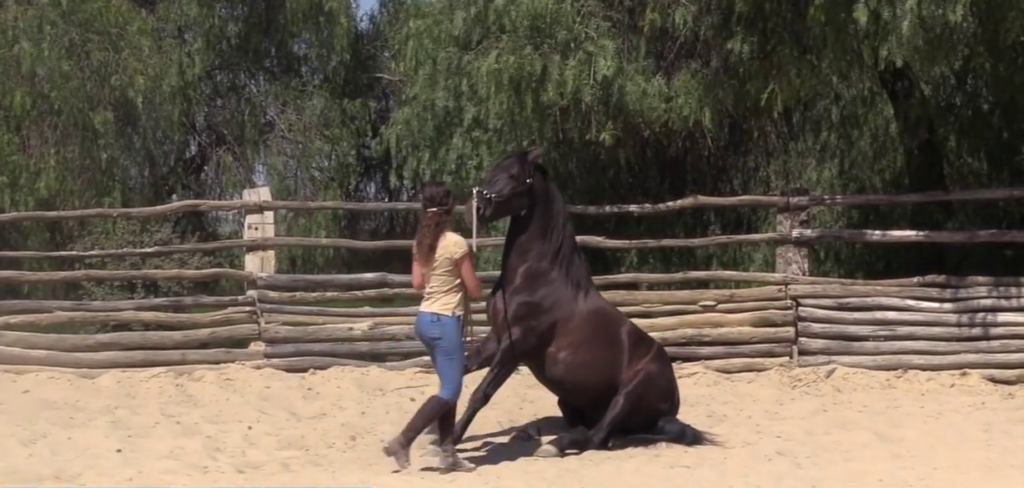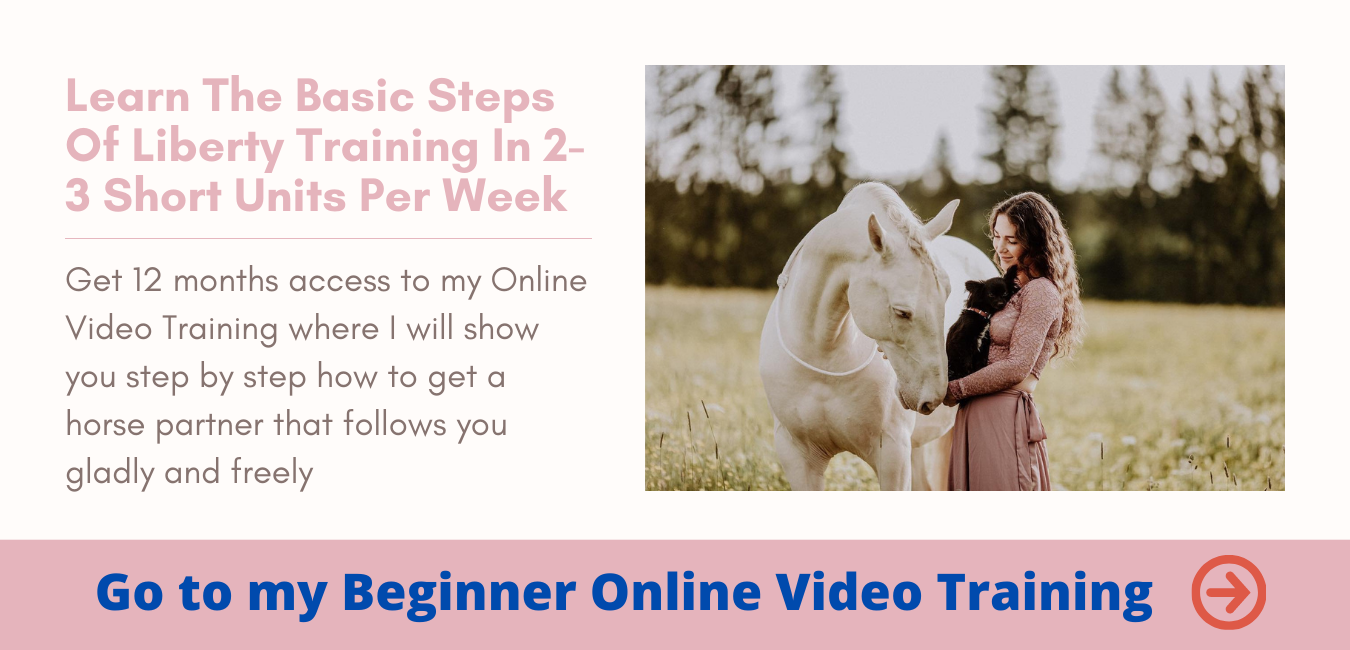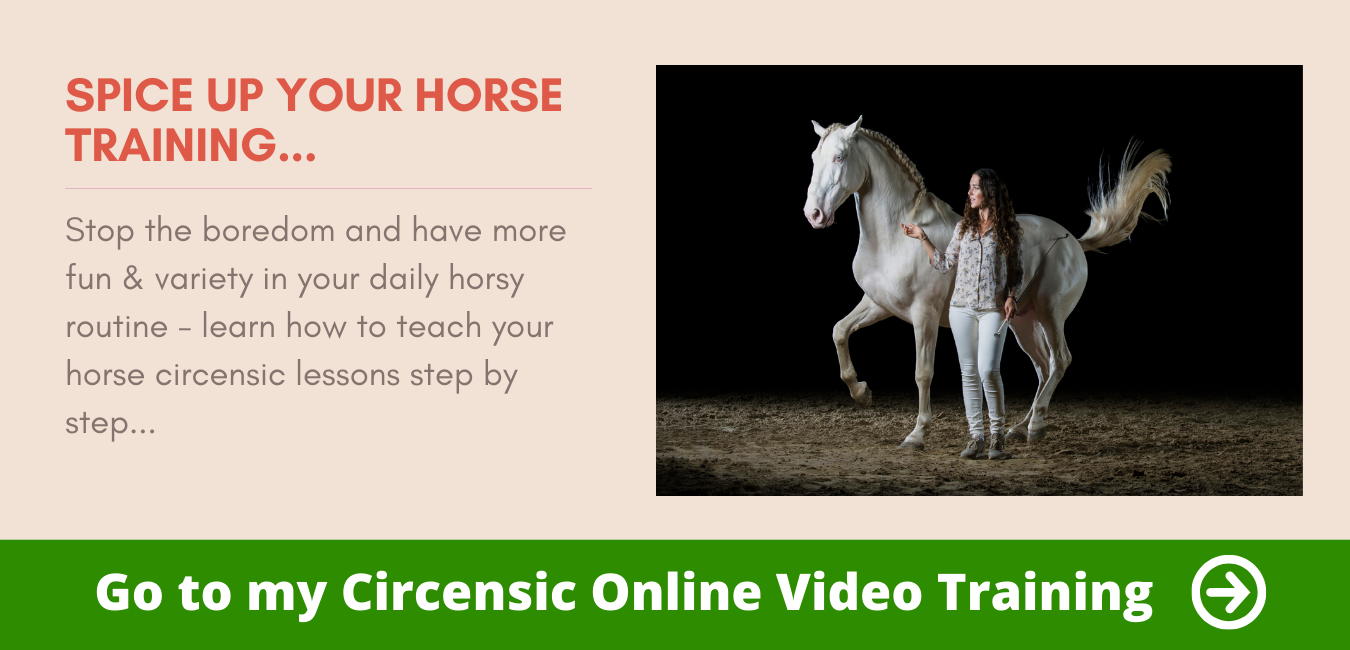I hope you’ve been able to work out quite a few tricks and lessons with your horse – and that, above all, you’re having fun doing them!
However, many horses have so much fun that they would really do anything for a goodie.
And unpack the full range of their skills if there is just a little hope of a goodie.
How you should deal with this and how you build up a good “signal control” is what today is all about ?
Signal control – what does it mean?
First, let’s define exactly what signal control actually is before I explain how you can implement it consistently in training with your horse.
That brings us to the magic word – consequence – but more about that later.
The most important point of signal control is that your horse shows a certain behavior on a certain signal.
Preferably directly and immediately – and not just any behavior, but always the behavior that matches the signal.
In one of my last livestream at my online intensive seminar, there was a participant whose horse, after learning the waltz, simply showed the waltz in every possible and impossible situation.
No matter if stopping or Spanish walk – the waltz had become his new favorite lesson.
The good thing is: you now know that your horse really enjoys the waltz (…or any other lesson, depending on your horse’s choice) and you can also query it in the future to praise your horse or to finish your training with a motivating lesson.
The downside: depending on which lesson your horse has picked as a favorite, the lack of signal control can become a serious problem sooner or later.
As funny and sweet as begging (e.g. sticking out your tongue with Attila) can sometimes be (yes, even I often have to smile there ?), it can quickly become dangerous if your horse climbs without being asked or suddenly pushes you onto the side with his hind end during the waltz.
So in principle it always makes sense to try not to encourage such “own ideas” of your horse at all!
Even though I appreciate horses that think for themselves – the more consistent you are, the more relaxed you and your horse will be in the long run!
Of course, this doesn’t mean that you can no longer smile at your horse’s clowning around – just always keep the framework in mind – especially, of course, with regard to your horse’s character.
Building a signal
In order for your horse to first learn to understand your individual signals at the beginning of your training, it naturally takes a lot of practice.
However, it makes sense, especially in advance, that you think very carefully about which signal you want to use for which exercise/movement.
Often I see people whose signals change again and again, although the horse is supposed to perform the same lesson – this is of course extremely confusing for the horse!
You should also avoid that different signals are too similar, because then they can easily be confused by your horse.
My signals therefore almost always consist of a combination of a body language signal and a voice command – this is simply how I try to make it as easy as possible for my horses.
To do this, you start by only giving the voice command at the beginning when your horse is already performing the desired exercise.
This way you give him the chance to link the voice signal with the desired behavior in the first place.
The goal is that the horse will eventually show the desired behavior only on the voice signal (or touching the reflex point, a hand signal, etc.).
By the way, this doesn’t mean that you can’t combine the signals later in more complex exercises.
We do that anyway, e.g. with the lateral walk, because we practice beforehand to move the forehand and the hindquarters independently of each other (no matter if on the ground or via the thigh, reins and weight aids under the saddle) and then combine these signals.
However, once your horse has internalized the signal, you should make sure that he does not anticipate your signal, even though he may already have an idea of what you want him to do.
You need a little tact here so as not to demotivate your horse.
Do both of you the favor of increasing the time your horse has to wait for your signal (e.g. when you bring him to you) over time.
Many horses don’t have much patience and have to learn the concentrated waiting step by step. And sometimes in small steps ?
When the child has already fallen into the fountain…
But if you have a horse that already shows exercises that you didn’t ask for, you can ignore the behavior in the first step – and in no case reward it with attention in any way.
Unfortunately, this also includes laughing ?
In any case, refrain from giving your horse a goodie for an exercise that was not asked for, no matter how beautifully he performed the exercise. Even if it is difficult!
If you can safely ignore the exercise, this is actually the best way to stop the behavior – provided the behavior is not self-rewarding.
For example, if your horse keeps wanting to graze while you are walking him, ignoring this behavior won’t help much.
This is because success is already implied, so to speak, if your horse catches even a blade of grass.
However, if your horse has chosen an exercise as his “favorite bedding exercise” that can quickly become dangerous, such as the climb, the Spanish walk, the waltz, etc., you should consistently stop this behavior.
For the waltz, for example, this means simply taking another step back in the free work and taking your horse back to the rope.
This way you can bring the head back to you with a short impulse on the rope and drive the hindquarters away from you.
However, always be careful not to become unfair!
Such things usually creep in because our timing is not quite correct or we have consciously or unconsciously rewarded our horse several times for this behavior.
Therefore it is our task to make our horse understand in a calm and relaxed way that he should only show this behavior when we ask for it ?
By the way, it doesn’t matter which signals you use.
Some of the body language signals I use are simply easier for the horse to understand, because they are based on the behavior in the herd.
But if you and your horse understand each other, the help you give doesn’t matter in the end – after all, that’s what your signal is supposed to be for your horse:
A help.
[su_youtube url=”https://youtu.be/OdNv31AYAnU”]
A good plan beforehand is usually half the battle.
Often it also helps to take a deep breath before a new exercise and to sort out your thoughts instead of training wildly ?
In this sense, I hope you continue to have a lot of fun with your horse!
All the love,
Your Kenzie




